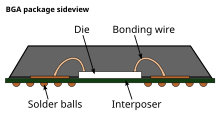An interposer is an electrical interface routing between one socket or connection to another. The purpose of an interposer is to spread a connection to a wider pitch or to reroute a connection to a different connection.[1]


An interposer can be made of either silicon or organic (printed circuit board-like) material.[2][3]
Interposer comes from the Latin word "interpōnere", meaning "to put between".[4] They are often used in BGA packages, multi-chip modules and high bandwidth memory.[5]
A common example of an interposer is an integrated circuit die to BGA, such as in the Pentium II. This is done through various substrates, both rigid and flexible, most commonly FR4 for rigid, and polyimide for flexible.[1] Silicon and glass are also evaluated as an integration method.[6][7] Interposer stacks are also a widely accepted, cost-effective alternative to 3D ICs.[8][9] There are already several products with interposer technology in the market, notably the AMD Fiji/Fury GPU,[10] and the Xilinx Virtex-7 FPGA.[11] In 2016, CEA Leti demonstrated their second generation 3D-NoC technology which combines small dies ("chiplets"), fabricated at the FDSOI 28 nm node, on a 65 nm CMOS interposer.[12]
Another example of an interposer is the adapter used to plug a SATA drive into a SAS backplane with redundant ports. While SAS drives have two ports that can be used to connect to redundant paths or storage controllers, SATA drives only have a single port. Directly, they can only connect to a single controller or path. SATA drives can be connected to nearly all SAS backplanes without adapters, but using an interposer with a port switching logic allows providing path redundancy.[13]
See also
editReferences
edit- ^ a b Package Substrates/Interposers
- ^ "TSMC to Expand CoWoS Capacity by 60% Yearly Through 2026".
- ^ "Highlights of the TSMC Technology Symposium 2021 – Packaging".
- ^ interposes - definition of interposes by the Free Online Dictionary, Thesaurus and Encyclopedia
- ^ "2.5D".
- ^ Silicon interposers: building blocks for 3D-ICs Archived 2018-01-30 at the Wayback Machine / ElectroIQ, 2011
- ^ 2.5D Interposers; Organics vs. Silicon vs. Glass Archived 2015-10-10 at the Wayback Machine / Rao R. Tummala, ChipScaleReview Volume 13, Number 4, July–August 2013, pages 18-19
- ^ Lau, John H. (2011-01-01). "The Most Cost-Effective Integrator (TSV Interposer) for 3D IC Integration System-in-Package (SiP)". ASME 2011 Pacific Rim Technical Conference and Exhibition on Packaging and Integration of Electronic and Photonic Systems, MEMS and NEMS: Volume 1. pp. 53–63. doi:10.1115/ipack2011-52189. ISBN 978-0-7918-4461-8.
- ^ "SEMICON Singapore 3D IC Wrap-Up: Bring down the cost and bring out the TSV alternatives - 3D InCites". 3D InCites. 2013-05-22. Retrieved 2017-08-21.
- ^ "The AMD Radeon R9 Fury X Review: Aiming For the Top". Retrieved 2017-08-17.
- ^ "White Paper: Virtex-7 FPGAs" (PDF).
- ^ "Leti Unveils New 3D Network-on-Chip | EE Times". EETimes. Archived from the original on 2016-07-15. Retrieved 2017-08-17.
- ^ Willis Whittington (2007). "Desktop, Nearline & Enterprise Disk Drives" (PDF). Storage Networking Industry Association (SNIA). p. 17. Retrieved 2014-09-22.